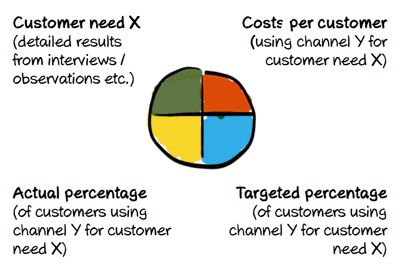Unlike products, services are delivered over time through a series of interactions between a customer and a service provider, which we call touchpoints. Service companies are typically structured around channels e.g. digital, direct, phone etc. As a result of this the budget is also assigned in the same way. To visualise this, the below sketch shows the structure of a prototypical service company.
You might think of your work in the context of a particular channel. Important to bear in mind is that your customers don’t care about channels or how your company is structured. Every interaction they have forms their experience regardless of channels. Their interactions are driven by a specific need or goal they want to achieve.
Let’s have a look at the journey of Susan who has just received a bill from your company.
In this example Susan chooses the – at the time – most convenient channel for interaction. A poor service experience within one channel is likely to drive her to another channel. Jumping between channels however is time-consuming and often results in a poor and inconsistent service experience.
Creating a consistent customer experience across channels is often hindered by channel-oriented structure and budgeting. Focusing on just one channel is not enough as it is the weakest channel that defines Susan’s overall service experience.
How can you design great service experiences across channels?
1. Break down the silos between channels.
Allow for cross-channel budgeting and create cross-channel teams that work together on a regular basis to improve the service experience.
2. Understand your customers. Use qualitative field research techniques like observing and interviewing your customers in their environment or the context they experience your service to truly understand who your customers are and to shed light on their needs and pain-points. Enrich your findings by adding quantitative data like common reasons for complaints and cancellations.
3. Develop your own service design framework.
Create a specific measurement framework for your company to get an overview of customer needs, the channels available, and the touchpoints that result.
4. Review and analyse all touchpoints horizontally.
Focus on the customer needs and approach the matrix horizontally instead of vertically. That is, analyse all touchpoints for one specific customer need (e.g. ‘Learn about a new service’) according to the criteria below. Keep an eye on what potentially drives your customers to a specific channel. E.g. the use of jargon in your bills might drive people to call the contact centre instead of checking their usage online first.
5. Evaluate your channels systematically.
Use the below matrix to guide your decision process.
PROMOTE a target channel for a specific customer need if it provides a good user experience at low costs. Try to serve most customer needs through this channel.
DE-PRIORITISE cost-intensive channels with a high actual usage. These channels should only be used for specific customer needs.
REMOVE channels for a specific customer need if the user experience is bad and the costs per customer are high. When removing an entire channel, make sure that you offer and promote alternatives.
MONITOR low-cost channels that offer a bad user experience for changes. Find ways to improve the user experience. Although these channels are unlikely to delight the majority of your customers, they might still be required by some.
Succeeding in creating world-class services requires moving our thinking beyond service channels and putting customer needs in the centre, and designing and improving services around them. Good service design is not about adding more channels to your offering just because you can (“We need a mobile app – every company has one!”).
Good service design is about conducting existing channels to work seamlessly together to offer a consistent experience. New channels are added as they become a preferred and cost effective option. The framework above can help you to measure and to design service experiences that delight your customers.
And of course, I’m here to help, get in touch and let’s talk through your service and how this framework can help.
Sign up to my newsletter below to receive exclusive content on service design, customer experience and omni-channel management (I share one or two posts every month).
Check www.innovate-strategy.com for more information and get in touch sebastian@innovate-strategy.com.
Posted by Dr. Sebastian Vetter






